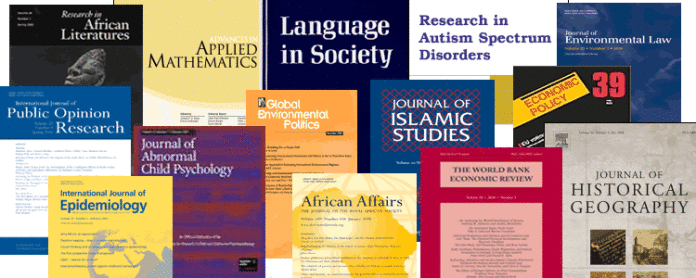A portfolio is an important document to show if you have the appropriate experience, sets of skills, and competencies that are needed to apply certain position or to be accepted in a PhD programme. Writing and publishing scientific papers can be one of the way to enhance your portfolio and can play very important role in determining your future steps. Salim, in this article, shares some tips on this particular issue based on his experience.
* * *
You might have just graduated from your Bachelor’s degree at an Indonesian university. You aspire to a good portfolio as part of your endeavour to make your dream—pursuing postgraduate studies overseas—come true. Or perhaps you are in the final semester of your Master’s study, either home or overseas, and are writing your research project report. You want to build an impressive portfolio which will boost your competitiveness in the job market or in applying for a PhD program at some point in your future journey. In such cases, creating additional portfolio pieces through the publication of your research findings (skripsi or thesis) in a scientific journals is one thing you might want to consider.
Writing and publishing your research papers in a good academic journals would bring about multiple advantages for you as well as the academic community, be it learning how to write a good academic piece, enhancing your own understanding on substance you are researching, disseminating your findings, and getting feedback from the reviewers.
Here are some tips for you who are considering publishing your research findings in academic journals to help your portfolio flourish.
Discuss your plan with your research supervisor. Usually it is not only the students who want to get published, the research supervisors (dosen pembimbing) would aspire the same thing since publications play a very important role for their career advancement. There is a well-known maxim among academics: ‘publish or perish’. Therefore, they should be happy to collaborate with their students to re-write the students’ theses in the form of scientific papers and then submit them to be considered for publication in good journals. I would suggest you to talk to your supervisor and tell him or her about your plan to publish.
You can talk to your supervisor when your research is progressing or upon the completion of your research, depending on your circumstances. By collaborating with your supervisor, who usually have experiences of publishing academic papers, you can expect to obtain valuable insights and learn the process behind the writing of a scientific paper. Further, if you and your supervisor submit the paper to a journal that charges a submission fee, you may get advice from him or her on how to cover the fee.
In some cases, some students or fresh graduates might be lucky enough since their supervisors approached them first and offered a collaboration. As a research supervisor for a number of final-year Bachelor’s students at one of Indonesia’s government colleges, I did so to my students. I made sure that they wrote a good skripsi. Once their projects concluded, I chose the most potential projects and offered a further collaboration. They were very happy to accept my offer. I usually asked them to improve some parts of their skripsi, and then I started the writing of an English-language academic paper based on such skripsi. Further, I also knew some friends and family members who accepted a collaboration offer from their respective supervisors and have presented their research papers at international conferences held abroad.
Determine the journal you are targeting. Surely you can opt to write your paper in Bahasa Indonesia and choose a nationally-accredited journal as an avenue to publish your research. However, it would provide you with greater advantages if you publish an English-language paper in a well-established international journals (indexed in Scopus or Thomson Reuters ISI). Albeit limited, a number of journals issued by Indonesian universities or institutions have also been indexed in Scopus and publish papers in English.
The quality and rank of a journal is another thing you will need to consider. If you are confident enough that your piece would contribute something significant to the body of knowledge, then you might want to target higher-quality journals. But if you are not confident enough, you can choose lower-ranked ones. The higher the rank of a journal, the more selective the submitted papers will be accepted. Publications in high-rank journals, of course, would be much more advantageous for your portfolio. Nevertheless, lower-ranked journals would still provide you with international exposure as well as valuable experiences. One thing to always remember: beware of those ‘predatory journals’!
Prepare a good paper. Some supervisors may be willing to write the research findings in the form of a good paper because they want to make sure the quality of such a paper. But it is important to note that not all supervisors would offer the same thing. There are many cases where the students or fresh graduates are expected to write the draft first, and their research supervisors would review the draft before submitting the final-version manuscript to a journal. Or perhaps the writing appears to be your own project and you should work on your draft by your own.
I know that, for most people, writing a good academic paper is not an easy task. But let’s put in mind that such a hard work would lead us to a greater good. Embrace the challenge. Learn how to write a good paper. Get inspired by reading those published papers in your discipline. Even when you have no sufficient access to international journal databases, you can still make the most of other platforms, such as Google Scholar, Academia, and Social Science Research Network (SSRN). You might not end up in a great piece in your first try, but you would be better off after constantly practicing. Please note that technical quality is an important aspect for a published paper, in addition to its substance and findings.
Once your manuscript is ready, you can submit your manuscript to the targeted journal. Remember to avoid any form of plagiarism. Never submit your paper to multiple journals simultaneously. The good news is academic journals mostly have an online submission system. Some journals even require no submission or publication fees.
Be patient to wait for the outcome and to follow up the reviewers’ comments. After receiving your manuscript, the journal editor would invite two or three referees to review the paper. The process is usually double-blind, where the authors don’t know who the reviewers are, and vice versa. Please don’t expect that you will receive the outcome in one week or two. It could be in two or three months! Also, brace yourself you to receive any form of feedback from the reviewers. You may have a sincere appreciation. You may have their ‘harsh’ criticisms.
There are four possible outcomes you will receive from the journal editor based on the reviewers’ recommendations: accept, minor revision, major revision, and reject. If your paper is rejected, it’s not the end of the world. Improve the quality of your manuscript (based on the reviewers’ suggestions) and submit it to another journal. If your paper needs a major revision, respond to the reviewers’ suggestions (time and resources permitting) and then re-submit the revised manuscript. But if you feel that you have no time or resource to follow up all comments provided by the reviewers, you can choose to withdraw your paper and submit it to another journal.
* * *
Image source: Hekman Library











